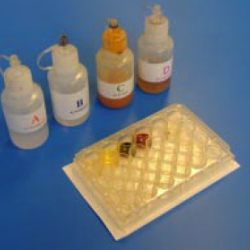Source Institutions
Source Institutions
Add to list Go to activity
Activity link broken? See if it's at the internet archive

In this chemistry challenge, learners systematically investigate which combination of four solutions produces a deep red color. The four solutions are iron(III) chloride, ammonium thiocyanate, tannic acid, and oxalic acid. Background information explains that it is the iron ions in solution combining with ions from the other solutions to create the different colors. After learners discover the different colors, they are encouraged to add a third solution to see if the color can be changed, an example of how chemical equilibrium can be shifted. This activity may take a bit more time with younger learners. For safety reasons, adult supervision is recommended and can be conducted as a demonstration for younger audiences.
- 10 to 30 minutes
- 10 to 30 minutes
- $10 - $20 per group of students
- Ages 11 - 18
- Activity, Demonstration, Experiment/Lab Activity
- English
Quick Guide
Materials List (per group of students)
- 5 pieces of white paper to provide a colorless background for the well plate
- 5 24-well plates
- 20 plastic dropping bottles
- Dilute solutions of iron(III) chloride, ammonium thiocyanate, tannic acid, and oxalic acid.
- Wash bottle with distilled water
- Paper towels for spills
- A container of clean water
- A safe container to dump solutions into and seal (waste container)
Subjects
-
Physical Sciences
-
Chemistry
- Chemical Reactions
- Solutions
-
Chemistry
-
The Nature of Science
-
The Scientific Process
- Conducting Investigations
- Gathering Data
-
The Scientific Process
Audience
To use this activity, learners need to:
- see
- see color
- touch
Learning styles supported:
- Involves hands-on or lab activities
Other
Components that are part of this resource:
This resource is part of:
Access Rights:
- Free access
By:
Rights:
- All rights reserved, Sciencenter,
Funding Sources:
- Camille and Henry Dreyfus Foundation, Inc.
- American Chemical Society
